cf development_in_layer_of_the_universe_in.
This story is the panoramic view that modern human beings can commonly take of what has enabled them to exist..
I don't think any human being could deny their own consciousness, their own awakening. (at least during standby mode) the feeling of existing and knowing.
Human consciousness seems to me to be the fundamental point on which human beings can be brought together..
It also seems to me the most important element in the field of experience and knowledge available to human beings..
I'd like to explore this further, even though it may seem obvious..
2.2.The concepts
A concept is a point of reference for the mind.
It's an abstract thing by definition.
This reference point may concern a concrete object or an abstract object.
Let's take a closer look: The concept of a chair refers to a concrete object called a chair..
The concept of "the chair" covers an indefinite number of perceptions of "the chair" that will have been different "chaises"..
The concept is structured in the mind by the repetition of experiences (or perceptions) that "look alike" and come together, which by "means" effect (mean, meaning, manas) in the structure of the nervous system, creates the concept of "the chair"..
The word "chaise" is just an index (analog index linking name and form) to identify this perception of the mind, the fruit of a very large number of perceptions of the senses.
To clarify this concept, let's give a few examples and analogies.
The analogy itself-even as an abstract concept, will be illuminated in a certain light that will give it the power so often denied to many of today's scientific minds..
language and, importantly, its roots, also give us clues to the acquisition of knowledge..
Locating, exploring and even exploiting its roots is not trivial, and since it is language that structures our knowledge, its importance and origin cannot be overlooked, as for example in man_in.
2.2.1.First a picture: The "bouts de bois' program.pieces of wood
The \"bout de bois\" program runs continuously in watercourses. .
During floods, branches, trunks and other planks float in the current of the watercourse, sometimes attaching themselves to an anchoring point. (a rock, for example) .
Soon, the hooked piece of wood becomes a new anchoring point for another piece of wood, and so on, until a veritable tangle is formed, and it's precisely these dams that can be seen along rivers..
When the dam gets big enough, it will reach areas with stronger currents. (current that he can-intensify by reducing the width of the watercourse at a constant flow rate) This creates an instability that will unhook part of the dam, which will flow back into the current it has created, either to break up completely or to anchor itself in another location more conducive to its development..
In this analogy, the stream is the mind, the sticks the perceptions, the aggregation of the sticks the concepts, the instability the evolution of language through the creation of new jargons..
The creation of new jargons stems from the mind's inability to remain stable in its own activity.: as it becomes unable to maintain the link between all these new concepts it creates through its activity, those-These become detached, independent, and create autonomous and unrelated conceptions, as well as mutually incompatible jargons..
The incompatibility in the analogy stems from the fact that one dam may resemble another in its parts, but does not involve the same dynamic of entangling pieces of wood..
The independence that makes the incompatibility possible comes from the fact that there are no wooden links between the dams..
The poet and the baby work on language in dual directions.
They will illustrate the very important and multiple notion of duality.
2.2.2.1.The baby
A baby, before having perceptions, does not have a command of language; it does not manage concepts..
These senses, in full activity, experience sensations that influence his nervous system, untouched by any conception, probably due to the shock of incarnation, which generates a temporary oblivion..
He lives in unity, his spirit is like a river whose flow is unimpeded by any dam..
For him, all sensations have only one meaning, since he experiences unity, and this meaning is his first concept, the concept of the world..
For him, the world is his mother, for she surrounds him completely. : all sensations are linked to the mother So the baby's first and most important concept is that of the mother, which will remain for a very long time.
Here we have the diagram: all the sensations in a single concept.
At birth, when sensations diversify, the child is plunged into confusion. (like wood in midstream) because all sensations can no longer be grouped under a single concept.
The nervous system acknowledges differences through its own discriminatory nature, polarizing in different directions..
The discordance of sensations will stress the nervous system, forcing it to adapt to several concepts and to an increasingly diverse experience..
The first concepts to be forged will be those that cross the largest sets of compatible sensations, sets that are large enough and coherent enough to form images in the structure of the nervous system. (macro-circuit) .
The situation here is one in which a large number of sensations generate a concept..
Later, it's up to language to enable the child to put some order into all these concepts..
For the poet, the situation is different: he has mastered language, but his sensibility is still active. (that's why he's a poet) .
Through the filter of language, a particular sensation, indescribable by any concept so far forged, because sensation too rare to create an average that the nervous system could conceptualize, can still be experienced..
The desire to translate it into the reference system (the language) will be irresistible - always this sacred (in the sacred sense of the word) need to unify, which is love.
The result is a beautiful poem evoking an indescribable sensation..
Where one word cannot convey a sensation, many words, well chosen in keeping with the desired vibration, will succeed in evoking it..
Here the situation is a large number of coherent words to evoke a single sensation.
In the \"bouts de bois\" program, the baby and the poet are two dams on the river of life: the baby is upstream, the poet who was a baby is downstream..
Can-is-is it the nostalgia for upstream that inspires the poet, and the space between the two dams that gives him the strength to write a poem, a legitimate attempt to unify these two distant dams through the flow of time?.
But the current only flows in one direction, as we know..
Scientists will surely see in the above something to do with Charles Fourrier, the dual bases of representation and the Fourrier transformation that allows us to move from one base to another while preserving the information..
This is the principle of holography.
2.2.3.Reality of concepts or concept of reality
The concepts we manipulate are only concepts, i.e. anchor points for the mind..
When we manipulate abstract concepts such as existence in this way, we are not manipulating the reality that the concepts represent, but only the concepts themselves..
This pre-exists upstream of our speculations, i.e. of the activity of the mind..
However, this does not mean that there is a total separation between concepts and the realities they represent..
For example, if we take the concept of existence, we are referring to Existence itself.-because we assume through our lives that Existence exists..
Here, by taking the word with a capital initial, I'm introducing at the conceptual level the idea that there's a reality underneath.-underlying-the concept and that without this reality, I wouldn't be here to carry out this activity..
In other words, I have to admit that Existence exists in order to accept my own presence in the world..
This is somewhat similar to the question "why is there-t-something rather than nothing?".
The concept is therefore for our mind a "pointer" that shows it the reality it designates..
Through the concept, our consciousness comes into contact with the reality of the concept..
So: "Existence" implies that existence exists.
The verb exist is the dynamic aspect of the noun existence and means "to experience existence"..
So to say that existence exists is to say: "Existence experiences existence" which means that existence experiences itself.-even.
Existence is therefore consciousness, which is also auto-And all this is also equivalent to Infinity, since there is no limit to the capacity of consciousness at this level of reality..
Thus the abstract concepts representing something absolute are all equivalent and can be deduced from each other by analyzing the properties of Existence..
In this way, we can see that Existence in its deepest sense is an ultimate reality that contains within it-even an infinite number of diversification possibilities.
It's analogous to the "unified field" concept of physicists who seek to derive all the laws of the universe from a single theory also called "the theory of everything"..
They have the right to do this research because modern science, which is a dialogue with nature using the experimental method, has shown them the way to unifying the laws of nature..
An anchor point in the stream of consciousness is necessary for the activity of the mind.
We could define the mind as the manipulation of the anchor points of consciousness by itself.-even Consciousness in its ultimate aspect assumes both the value of the flow, as well as the limit value of the first anchoring point.
Here the entire space meets the point.
The auto-of consciousness is the generator of complexity. (analytical and synthetic) The auto-reference, in essence, is neither analyzable nor perceptible, because we can only analyze or perceive an object.
In the case of the mind, the object is a concept, a feeling or a subtle sensation..
In the case of perception, it's a material object that passes through the sense organs, which are linked to the mind..
But the auto-reference is not posed as an object, since posing as an object implies the subject and observation of the object..
When you make the mistake of putting the auto-reference in terms of the object of analysis, the analytical mind is confronted with paradoxes.
The auto-reference under the effect of an attempt at analysis, literally explodes in the face of the analyzer.
There are many examples in science of this explosion process.
And these examples are always conceptually enriching..
For example, in the case of recursion.
A process is said to be recursive when, in order to complete itself, it calls on itself-same, leading to a loop of repetitions.
which is controlled or not, by the nature of this loop.
This is an example of self-reference.
2.3.1.. L informatique et la récursivité : the combinatorial explosion of response times
Example of the Hanoi towers.
The famous Hanoi Towers problem is a perfect illustration of the problem of the analytical and the synthetic..
According to Buddhist monks at a Hanoi monastery, the end of the world will arrive when the
The conical stack of 64 disks making up the first of the Hanoi towers will be placed on the third in the same order..
The discs have different diameters, and a disc with a smaller diameter than another must never be placed under a disc with a larger diameter,
The disks can only be moved one by one on the three tower slots..
It's easy to do this experiment with multicolored plastic rings of different sizes from the games for small children..
When the number of disks is low, they are easy to handle, but when the number of disks is high, they are easy to handle.
number of-beyond a certain limit, which is rapidly reached... get lost.
In this problem, the analytical solution based on a linear algorithm is
complex, costly and necessarily limited, while the solution
recursive (or global or auto-referent or synthetic) is immediate and complete.
Writing the solution in a computer language that supports the
recursivity (such as the C language) is simple and takes only
a few lines, whereas writing in linear programming is at the limit of what can be envisaged.
The simple program is called-itself, it is said to be recursive.
Program execution on a linear machine is fast
made impossible if the Hanoi towers contain a sufficient number of
disks, as the battery's memory will be quickly depleted..
If you can run the program on a machine with ten
disks, so with eleven disks, you'll need a much larger machine.
powerful.
It's a bit like having to walk a certain distance to get there.
distance, and that each new step would require as much energy as all the previous ones.
already accomplished: at first no problem, but very quickly take a step forward
would become a difficult task, the next would be terrible, then the next
superhuman, at last the next impossible.
A logical expression is said to be recursive when, in order to define itself, it
calls on her-even.
For example, A =
A is true
defines the logical expression
name "A", which is self-affirme.
It is said to be self-referential.
If we take the opposite expression B =
B is false
we arrive at a paradox.
In fact, we can ask ourselves whether B is true; if we assume it to be true, then we are asserting at the same time that B is false,
which is contradictory: if we assume that B is false, then it follows that it must be true..
B cannot therefore exist, since it denies itself-even.
We can thus see that self-reference cannot be negative because it is self-destructive....
Two fundamental mechanisms therefore derive from the auto-reference:
- a creative mechanism
- a destructive mechanism.
We find here the Vedic vision of the trinity: the designer: Vishnu, the destroyer: Shiva and the balance between the two: Brahma.
In quantum physics, a calculation method that greatly simplifies certain calculations consists in factoring the Hamiltonian into a product of two operators: creation and destruction operators.
By applying the creation operator to the fundamental state of the system, which is easy to calculate, we obtain the following state and recursively all the states of the system.
The Richard_Feynman
who came up with this method.
2.3.2.1. Gödel's incompleteness theorem
This theorem basically states that any formal system including logic and arithmetic is incomplete..
In other words, there will always be unanswered questions in this system, or rather assertions that we'll have to choose whether to consider true or false..
And it is this choice that extends the formalism.
Indefinite extension proved by the theorem.
Gödel used recursive reasoning to demonstrate his theorem.
Théorèmes_d_incomplétudes_de_Gödel
les_théorèmes_d_incomplétude_de_Gödel_science_étonnante_37
So from simple basic data an infinite creativity is derived.
Intellectual analysis never ends.
It's an application of the creative principle of self-reference And a fundamental result of mathematical logic.
2.4.1.. l'expérience commune de la conscience :the shared experience of consciousness
As human beings, we can only bear witness to our own experience..
We are present during the waking state and we have perceptions.
We perceive the world around us, and other human beings can also perceive us in return..
We can therefore be both subject and object..
The diversity of possible experiences or perceptions is unlimited.
But it's the same capacity to be conscious for all human beings and for all experiences..
We can therefore say that, in a way, by considering the concept of consciousness, we have unified the entire observable universe, and found an invariant to all this diversity of experience..
A conceptual framework that encompasses the totality of phenomena a human being can experience.
Analysis of consciousness leads us to distinguish the fundamental elements that structure it.
When consciousness functions, it means that a subject (the conscious subject) perceives an object.
The first object that could be perceived by a conscious being is its own consciousness.-even : I experience that I am conscious: I experience my own consciousness.
This can-be imagined from the following situation where you instantly lose your 5 senses of perception, including the internal sensation of touch (kinesthesia) .
In this fundamental experience, we notice that the subject is conscious of the fact that the most intimate object for this conscious being is its own consciousness.-and that the means to achieve this experience is also its consciousness..
This underlines the auto-referent of consciousness: consciousness needs no external element to experience itself.-even.
It's the simplest experiment imaginable, since it requires just one element: consciousness.
In mathematics, we have a similar situation, but it only concerns the object..
This is the initial axiom of set theory, from which all other mathematical theories are derived..
This axiom says "there exists a set" and as no other mathematical object has yet been created, since we are at the level of the foundation of mathematics, this set is empty..
This is precisely the empty set.
The first axiom of set theory is, in fact, the assertion that we can consider sets.
This is the fundamental dynamic that structures the whole of mathematics, starting with arithmetic..
The number "zero" is itself-even the empty set.
The number "one" is the set that contains the empty set, the number "two" is the set that contains both the empty set and the set that contains the empty set, i.e. zero and one Three is the set that contains zero, one and two.. We say that 3 is the successor of 2 in this process, 2 the successor of 1, 1 the successor of 0..
If we continue in this recurring way, we define the set of integers as the set containing zero and all its successors.
The statement that such a set exists, i.e. a set that contains an infinite number of elements, is the second axiom of set theory, the infinity axiom..
This image represents the number nine formed from the empty set.
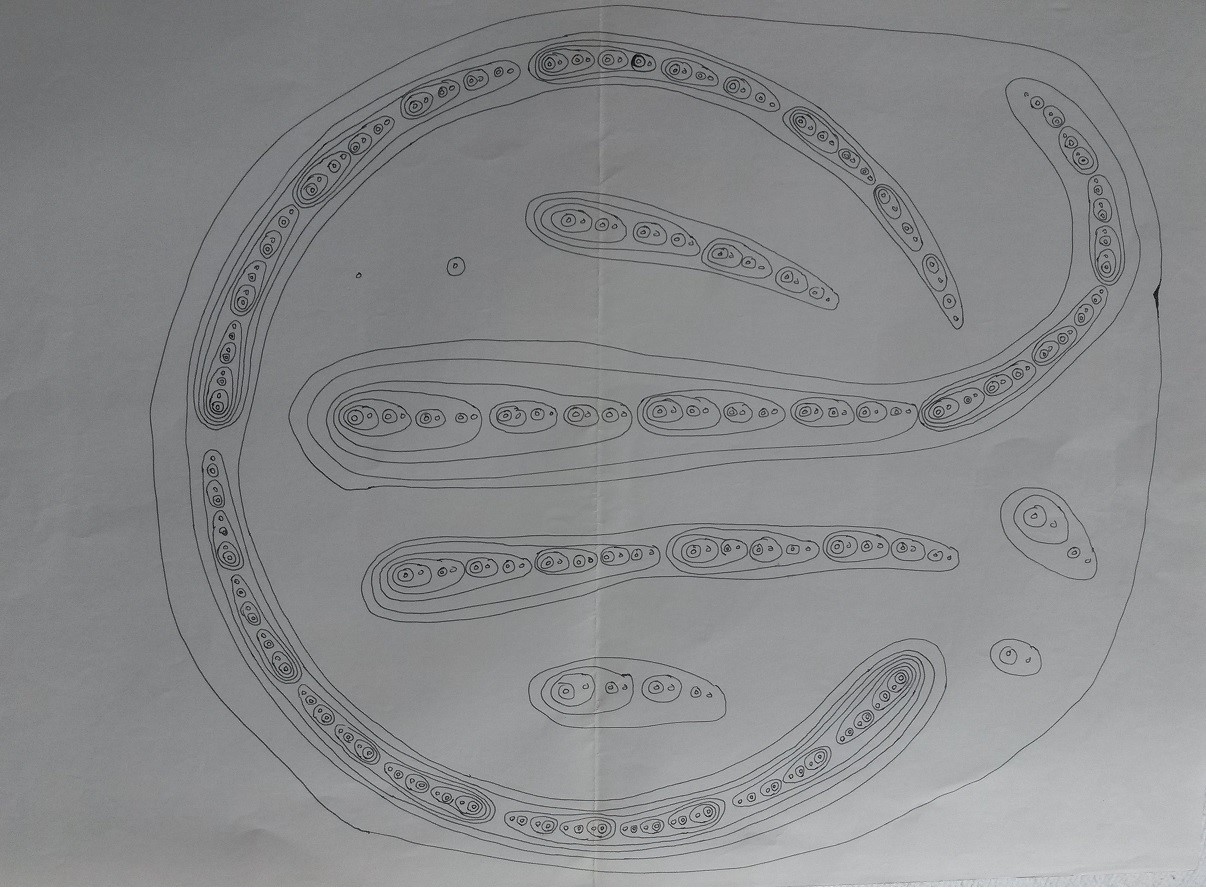 to reproduce the drawing, which is ultimately a mandala (which means circle) :
to reproduce the drawing, which is ultimately a mandala (which means circle) :
- draw a circle,
- then surround it with a new circle
- reproduce on the outside of this new circle what's on the inside, i.e. a circle
- circle everything drawn (the circle that surrounds the circle and the circle that reproduces )
- it forms a new circle that encompasses everything (the known) and repeat, drawing on the outside what's inside this new circle.
- And so on...
We can proceed with the same logic to derive not the set of objects that it is possible to conceptualize, but the totality of the experience that consciousness can make of it.-even.
Zero contains infinity in potential.
Likewise, consciousness in its state of emptiness (without object, subject or knowledge other than the process of consciousness itself) contains all the potential for experimentation.
2.4.2.1.The self-reference of consciousness
By definition, auto-reference is the act of referring to oneself-even.
As we have just seen, consciousness possesses this self-referential character
and even seems to be an essential characteristic of consciousness.
2.4.2.1.1.. l'autoaffirmation de la conscience :self-affirmation of consciousness
Again, let's consider this remarkable thing, which is the fact that I, being conscious,
am aware of my consciousness: that I am aware.
So I can say: I am aware that I am aware.
Since consciousness is what I know, when I say "I am aware that I am aware",
I assert knowledge from it-even.
There is no
external to my consciousness that allows me to affirm or deny this first knowledge..
My conscience is self-affirme.
The auto-affirmation of my consciousness by my self-referential consciousness.
The idea that consciousness is self-referential by nature is the assertion that it has
the ability to describe herself-and to experience herself-even.
By experiencing herself-we're not just referring to the experience
described above (that everyone can recognize that they are conscious, and that it is precisely their
consciousness that allows him to assert it) but also that consciousness must be able to experience its own
internal structure, and even that this is what she is constantly doing..
Existence, consciousness and self-reference are concepts_in that exist in my consciousness, they are manipulated by my mind, which can be defined as the manipulative faculty of consciousness, which is discrimination or intellect..
Other experiences a conscious being can have (make it real) must be deduced from this fundamental experience by virtue of the principle of simplicity.
The principle of simplicity is used in science to evaluate theories.: a theory will be all the more powerful if it explains the maximum number of phenomena with the minimum number of presupposed concepts.
Initially, the subject is consciousness and the object is also consciousness..
The ability of consciousness to relate to itself-itself is nothing other than consciousness.
Consciousness is not an object, but it is the source of all objects..
Consciousness is not a subject, but it is the source of all subjects..
Initially, when consciousness observes itself, it simultaneously assumes the function of subject and object, as well as their relationship..
Consciousness is subject, object, as well as the relation of knowledge or experience between subject and object, the relation between subject and object, the relation between subject and object..
We say that consciousness takes on the coloring of the subject by assuming the point of view of the subject, and that it correlatively takes on the coloring of the object by assuming the point of view of the object..
When we say "Au départ", we're actually talking about the beginning of reasoning, not the beginning of the process of consciousness, which has no beginning and no end..
The pre-exists before space and time.
In fact, it should be noted that this reasoning takes place within our very consciousness..
As we are ourselves-even immersed in space-time, we're not talking directly about consciousness, but about a model of it.-projected into the sequence of discourse that takes place over time.
From this first duality between subject and object emerges at the same time in the process, but in sequences in the discourse, the relationship between the two..
The relationship between subject and object is called experience or knowledge..
2.4.2.2.The principle of simplicity and the principle of unity
Physics theories, for example, make extensive use of this principle.: if one theoretical framework describes more phenomena than another, by encompassing it, it is the former that will be considered "true" , it corresponds to a more powerful theory.
The principle of simplicity is linked to the principle of unity: it's simpler to have a single theoretical framework to describe all phenomena, and if we have a unifying theoretical framework, that means it corresponds to a deeper understanding of the universe.
If there is a conflict between two theoretical frameworks, because they describe different sets of phenomena, but with radically different conceptions that are incompatible for current understanding, it is because there is a conceptual framework to which understanding does not yet have access that allows the two theories, and their preferred phenomena, to be unified..
For example, general relativity and quantum mechanics.
To illustrate the principle of unity, we can say that: The very fact that human science exists: the use of the conscious mind to describe the phenomena observed by this human mind, is a clear indication that consciousness plays a predominant role in physical phenomena..
Again, this may seem trivial or simply "goes without saying" but it's also fundamental..
In fact, if there were no connection between physical phenomena and consciousness, the latter would be the only one.-could not logically describe them.
And if there is a deep connection between phenomena and consciousness, it is because there is a unique framework that unites them..
2.5.An overview of Vedic cosmogony
The deepest and purest expression of our own origins to which I have had access is undoubtedly the Vedic cosmogony or Vedic science..
The preceding discussion of consciousness is directly inspired by this knowledge..
This knowledge came to the West through a great spiritual master, Maharishi Mahesh Yogi, who presented this knowledge for over fifty years..
The Vedas are probably the oldest body of knowledge known to man, and form the basis of Indian literature..
Other cosmogonies, or worldviews, are no less interesting because they emphasize particular values and are either derived, equivalent, more metaphorical or more directly pragmatic expressions, such as the vision of Toltec shamans..
The Vedic vision also presents itself as a unifying framework of knowledge..
From the point of view of Vedic science, the first anchor is consciousness itself.-even.
The whole of creation can be derived from consciousness.
The Sanskrit term used is "Samhita" which means both "sequence" and "totality"..
Samhita is nothing other than Consciousness.
The term "Samhita" or "sequence" comments on the very fact that initial, or original, or pure Consciousness will sequentially develop from its own value the totality of its potentialities, which also includes the totality of the material universe..
The totality of the expression of consciousness is therefore the Samhita.
Samhita is the sequence of three elements that make it up, or rather derive from it.
These three elements are represented by the Sanskrit terms "Rishi", "Devatta" and "Chandas"..
- Rishi is the subject value of consciousness
- Chandas is the object value of consciousness
- Devatta is the knowledge or experience value of consciousness
Thus, Vedic science recognizes that totality can be seen as the sequence of subject, object and their relationship, i.e. experience or knowledge..
From the point of view of scientific pragmatism, the above is interesting for at least two reasons:
- we start with a unique concept: consciousness, thus satisfying the principle of unity or simplicity.
- it's all about human knowledge, and all human experience is part of the subject-subject relationship.-object, since the human being knows from his consciousness.
In physics, this is achieved by first defining the frame of reference, which is in fact the point of view from which the observer places himself..
I remember the quantum mechanics course "the hydrogen atom model" given by the professor Richard_Wallace from Mac Gill University in Canada, which began precisely by a general consideration of human experience and the placement on the board of the observer's frame of reference, then that of the object under study, the hydrogen atom and their relationship and the structure of the object. : the electrical force between the electron and the proton, leading to the. équation de Schrödinger of the hydrogen atom in order to simply derive the solutions recursively by the method of creation and destruction operators by factoring the operator hamiltonia_en.
And all this with just chalk and a blackboard as your only tools..
In this way, totality is initially a unit: the samhita_enthen trinity in the " sequencerishi_en, devatta_en and chandas_en".
2.5.1.The dynamism of consciousness
The transition from unity to trinity is made by recognizing the dynamism inherent in consciousness, and we can speak of the "physiology" of consciousness..
This dynamism is the movement of consciousness within itself.-even.
This dynamism is the expression of the first duality: from silence to dynamism.
Before the first expression, Samhita is seen as a unified, motionless totality, but by its very nature it possesses the capacity to be self-aware.-and thus explore its own value.
In so doing, it becomes aware of its own ternary nature, through its own dynamism..
At the same time, all this is its own nature, which we are trying to describe on the basis of its limited value.-even : nous-even.
Having achieved this, consciousness remains-even in her-even the unified totality, and this can be seen as a return to the primordial silence of consciousness, frequently referred to as the Source..
This dynamism can be seen as the successive passage through two states: the silent state of consciousness and the dynamic state of consciousness.
So we can see the dynamism of consciousness in terms of a fundamental vibration.
The frequency of this vibration is the frequency of consciousness.: infinie.
Once again, this is not a physical frequency, since the physical world has not yet been created..
The word infinity shouldn't scare us, even if we are physicists. The first infinities in physics appeared when a force was first quantified.: electromagnetism in quantum electrodynamic theory.
The mechanism of this dynamism is a 2.5.1.1.Polarization
.
The polarization of consciousness.
We'll say that the appearance of a duality is due to the polarization mechanism.
In polarization we have a complementary pair of two opposite poles.
A basic example of polarization is the two poles of a magnet generating a magnetic field..
This can be analogously compared to the notion of the vacuum state of the field in quantum physics..
The field in its fundamental state (or lower excitation) contains no particles, its energy is zero.
On the other hand, in the form of fluctuations or virtual particles, it contains infinite energy..
As these fluctuations are virtual, they cannot be observed..
Physicists refer to this as vacuum polarization..
At any moment, pairs of particles can spontaneously appear from the quantum vacuum.-virtual antiparticles: proton-antiproton, electron-positon, etc.... These two states of consciousness can be represented geometrically by a tetrahedron.: The top point forms the apex of the tetrahedron_en is the samhita_enbelow, the basic triangle is formed by the three points representing Rishi (subject) , Devatta (relation: experience or knowledge) and Chandas (object) .
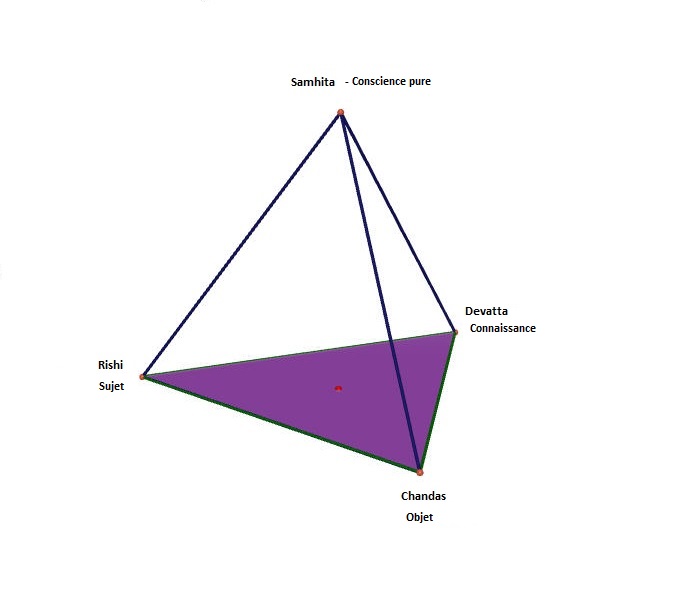 If we consider a particular point of view, silence or dynamism, the tetrahedron presents a dissymmetry: a point on one side, a triangle on the other ; silent value no-and the dynamic value during manifestation.
If we consider a particular point of view, silence or dynamism, the tetrahedron presents a dissymmetry: a point on one side, a triangle on the other ; silent value no-and the dynamic value during manifestation.
If, on the other hand, we take the point of view of the center of the tetrahedron, we find ourselves in a symmetrical situation where no point of view is privileged..
We can say that when we move the point of view "without a particular point of view" to a particular point of view, would only be-that of the unified totality (samhita) then "dual" the opposite point of view of diversity appears.
The very fact of geometric representation implies the existence of a space..
A space of consciousness.
To get an idea of the nature of this space, simply close your eyes and imagine an infinite, totally empty space and the presence of your consciousness in this empty space..
At this level, there is equivalence between the point and infinite space..
Indeed, if we imagine an absolutely empty space, we understand that we cannot distinguish between any of its points since, being empty, we cannot locate one point in relation to another..
Imagine-yourself in such a space and you'll see that in fact there is no space, only the potentiality of space..
Since we cannot distinguish between two points, we cannot consider them as separate either..
How could-we say here or there, since there is no reference and nothing on which to base a distinction between "here" and "there"..
It is the space of consciousness in its most silent form..
The unity of the point and of the whole of space, just as the empty set contains by its dynamism the potentiality of all possible sets.
This space of consciousness is a latent potentiality of consciousness..
Space is created by the dynamism of consciousness.
When consciousness projects itself inside its own value and identifies first with the subject, it creates a stretch..
It is this stretching that creates the space from the point.
This space is not physical space, but the space of consciousness..
It is the distinction or difference between subject and consciousness that creates the space of consciousness..
It is therefore consciousness's capacity to discriminate that creates distancing and therefore space..
Intellect is the capacity of consciousness to discriminate..
Here we highlight the expression of the first duality in the geometric domain: point and segment.
We can link the point to the silent aspect, and the segment to the dynamic aspect, to movement from one point to another..
Elisabeth_Haich_en in his book Initiation
(p224) expresses this idea in relation to the vibration of the point.
The point begins to vibrate and thus creates the segment, the dimension one..
We'll come back to the notion of dimension in relation to space.
In Einstein's special relativity, we find an equivalent idea that we can call . l'instant d éternité .
If the points acquire differences-will enable distinctions to be made and distances to be defined..
The basic idea is that if a distinction cannot be made, then there is no perception and therefore no perceived reality..
Each point is a point of view.
A point of view within the space of consciousness.
Initially, there are four points of view: the point of view of totality, which is in fact the source of all points of view, the point of view of the subject, the point of view of the object, the point of view of the relationship between subject and object.
The three segments that run from the point of totality to the three elements that make it up are therefore the movements of consciousness.
During these movements, consciousness assumes the value of what it sees..
When she sees the subject in herself, she colors herself with the subject aspect she recognizes in herself, she says: "I'm on topic".
In so doing, it identifies with the subject and becomes the subject itself..
Thus the subject value of consciousness appears : "Rishi".
A point of view in consciousness is assumed and experienced by consciousness.
In the same way, when consciousness projects itself into the object and sees itself as an object, it becomes the object itself..
It is colored with the object value "Chandas"..
Once again, consciousness projects itself in its capacity to know, and "Devata" appears..
Here's an important point to make.
Everything that has been described exists or-exists within consciousness.
From the point of view of the totality, it's all one thing, which is nothing other than itself.-even knowing herself-and knowing oneself brings out a number of qualities that can be described in detail below..
Each element described always fits within the framework of a point of view of consciousness.:
- rishi_en is the "knowing" point of view of the Samhita or consciousness.
- chandas_en is the "known" point of view of the Samhita or consciousness.
- devatta_en is the point of view "knowledge" of the Samhita or consciousness.
2.5.2.. le coeur et l'intellect : the basis of dynamic consciousness
The process that details the internal physiology of consciousness is an analytical one..
Consciousness, in examining its own value, uses its ability to make distinctions.: I know myself as the original consciousness, but I am also the subject, the object and their relationship..
Consciousness's ability to analyze is the Intellect, the faculty of discrimination..
On the other hand, the ability of consciousness to be unified by nature is in itself the ability to unify its own qualities..
This unifying faculty is the heart or love..
Love can be defined as the ability to unite, the force that unifies..
These three segments are traversed in their original direction by the ultimate consciousness, the Samhita..
A segment can be oriented in either direction, in which case two arrows indicate the direction of travel..
The first three projections of consciousness - subject, object and their relation, being nothing other than consciousness - possess the same characteristics of consciousness.
In this way, the emerging subject value or Rishi can make the reverse movement of consciousness and merge into the unity consciousness..
It returns to its original source by abandoning identification with the subject.
Indeed, when consciousness is colored by the projection of an element of itself-even so, it loses nothing of itself-Even so, she remains totally aware and conscious, so she can realize from this projection that it's only a projection of herself.-and return to its primordial state, samhita or totality..
This return to unity or unified consciousness is called the return to the Self..
The Self being the ultimate consciousness, or simply consciousness.
In terms of the functioning of the human mind, it is the experience of transcendence, the return to interiority of consciousness previously projected towards the objects of the senses, the external world, or mental activity, the internal world..
This is precisely the subject of the system of Indian philosophy that is Yoga..
The value of experience or knowledge "Devatta", fully conscious can also make the way back as well as the object value "Chandas"..
All these elements thus recognize their origin, and through this movement restore the unity of consciousness, which would otherwise be lost..
We can use the geometric representation of the tetrahedron, in which the vertices are the four primordial points of view, and the segments that connect them, the discriminating activity of the intellect that creates them in one direction, or in the other direction, the return to unity..
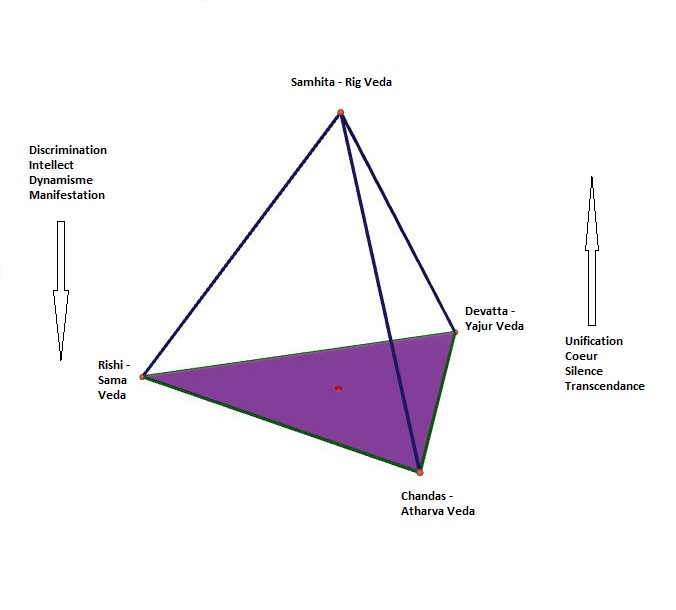 A second duality that emerges naturally from consciousness is the Intellect duality.-Heart expressing the inherent dynamism of self-aware consciousness-even.
A second duality that emerges naturally from consciousness is the Intellect duality.-Heart expressing the inherent dynamism of self-aware consciousness-even.
In geometric terms, the tetrahedron is its own dual, or autodual..
In terms of graph theory, the graphe_tétraédrique
is also its autodual.
The wikipedia page also contains the following image as an example of a tetrahedral graph, which can easily be compared to the structure of the Samhita.
An example of the universality of this fundamental concept.

This inherent dynamism is the primordial vibration in the space of consciousness..
This vibration is not a physical vibration, it is a vibration of points of view of consciousness..
We can say a virtual vibration of infinite frequency.
The process can be seen from two different points of view.
The point of view of "simultaneous" or rather eternal totality and the sequential point of view, where we pass from one quality or "state of consciousness" to another quality by a sequential process..
The whole concept of samhita as both sequence and totality.
The word "simultaneous" is enclosed in quotation marks and is more accurately replaced by "eternal" because time has not yet been created, just like physical space..
We also have a third duality here, the "state duality.-processus".
Samhita can be seen as the state that is itself-even the process of consciousness.
In Samhita, all dualities are unified, i.e. perceived as a whole..
For example, in the cosmogony of "Lao Zi", the "Dao De Jing".
This is the image of the "Dao" which represents the duality "Yin-Yang".
In the "virtual" or rather "real non-physical" space of consciousness, the sequence of passing from one point of view to another can be considered as a "virtual time" a time of consciousness..
In this time, paths can be travelled in any direction, there is no arrow of time as in physical time, and no irreversibility either..
And since these paths are travelled at infinite speed, we have simultaneity, or more precisely, as we said, eternity..
By comparison, we can see that in special relativity space we also have a space empty of all matter, where only light exists and travels with a finite speed limit..
We are therefore in a physical space because of this finite speed..
They include . l'instant d éternité which gives us an indication of how physical space arises from the space of consciousness.
It's like a landscape that can be viewed globally from the top of the highest mountain, or through the window of a train passing through the valley..
On the train, you see a succession of images flash by, and from the top of the mountain you can see the whole landscape at once..
In fact, the human eye possesses both of these abilities: the precise vision of the macula in the center of the retina, which proceeds in successive strokes, and the blurrier peripheral vision of the rest of the retina, which functions as a whole..
We can introduce other analogies to consider the articulation of these points of view.
If the sequence of different states is run through at ever-increasing speed, this sequence will be perceived as static, in the same way that a film is made up of a sequence of images, but presents a continuity for the eye due to the high frequency of the succession of images..
In the same way, matter appears stable to us when in fact it is an extremely rapid dynamic process..
It is this dynamism that is exploited by modern science and technology..
Trivial example: the combination of fuel and oxidizer, which are stable fluids, reveal the dynamism underneath.-underlying this apparent stability.
Let's continue the process of unfolding consciousness.
We said that the segments of the tetrahedron all have a meaning..
Segments are the links that allow you to move from one point of view to another..
We have seen this for the three segments that emerge from the central point of the Samhita.
In terms of Vedic literature, the above is represented in minute detail in the text of the Vedas..
The word veda, or ved (in Sanskrit, the terminal "a" is not explicitly pronounced "véd".) means him-same "knowledge".
The Vedas are composed of four books, each of which represents one of the four values described below.-before.
- the rigs-veda is the knowledge of the value samhita or totality of consciousness.
So it's the self-a commentary on consciousness-even.
From this comment comes the creation of the universe.
- The sama-veda is the analysis of knowledge from the point of view of the knower or rishi.
- atharva-veda is the analysis of knowledge from the point of view of knowledge or devatta.
- le yajur-veda is the analysis of knowledge from the point of view of the known or chandas.
The other three segments of the tetrahedron link the three fundamental elements of consciousness: subject, object and their relationship.
In this way, at each stage, consciousness continues to get to know itself by assuming increasingly detailed views of its own nature..
At the same time she remains-and this is also its very nature, to be self-sufficient.-referent.
Each new point of view-even consciousness, it is able to project itself into other points of view.
For example, when the initial Rishi from the Samhita considers the initial Devatta, i.e. the particular quality that enables him to know, this is a new point of view, a new coloring of consciousness..
The "Rishi looking at the Devatta" is no longer the original Rishi but a new quality of consciousness associated with this new point of view..
Also the point of view "Chandas" or the object that is also only consciousness is therefore able to see itself as an object perceived by the subject "Rishi"..
It assumes the reality "I am object of me-same who observes me", he can also consider the way he is observed thanks to the "devatta"..
These are two new points of view-themselves have an unlimited capacity for awareness and can therefore analyze their situation and its consequences..
It also underlines the identification capacity of consciousness.: "What we see we become".
If we constantly focus our attention on depressing subjects, we'll end up feeling really depressed..
Conversely, if we focus our attention on ever greater happiness, that's also what we'll develop..
The rigs-veda is the knowledge of the unfolding of samhita.
It's a self-deploying-frame of reference.
An auto-commentary that unfolds in a fractal manner, creating successive levels of commentary elaboration.
For example, the first word AGNI means primordial fire. (the dynamism of consciousness) is structured as a self-comment.
The first letter, which is the first to emerge from infinite silence, is the primordial sound that represents this infinity. It is also the first letter of the syllable "AUM" for the same reason..
This is the most fundamental vowel, and the sound is continuous to express its totality..
The second letter G is a consonant that implies a stop, a break, a collapse of the whole..
the "Gue" sound produced by locking the throat.
A duality therefore emerges: totality and limited value, infinity and finiteness. This highlights the fact that totality, which contains everything, must also contain limits, the finite..
This also indicates the possibility of creating finite value from infinite value..
This is related to the renormalization process in quantum mechanics to remove infinities from the equations of quantum field theories..
The third letter N comments on the fact that we have passed from A to G through negation, opposition, opposite value, the passage from unlimited to limited..
The fourth letter I, which represents movement, indicates that the above is the fundamental movement of consciousness, namely the infinite frequency that makes it oscillate between the value of the totality of samhita and the unfolded value of its elements, which is in fact the "big bang of consciousness"..
Maharishi Mahesh Yogi presented the self-commentary of consciousness that is the Rig Veda, which unfolds fractally on several levels - view image.
2.5.4.1.Rig veda commentary

This is to link with the quantum vaccum dynamics identified by the physicist Nassim Haramein : nassim haramein double tore vortex circulation
It's easy to understand that, with the capacity of consciousness to constantly create new points of view, a veritable \"big bang\" takes place within it.-bang,
a combinatorial explosion of all the possibilities of points of view contained in consciousness, possibilities which are, for
unlimited nature.
It's an inconceivable bubbling from an increasingly specialized point of view..
It is logical to think that there are infinite levels of generation of new points of view..
This description is discrete, i.e. it uses whole numbers. (discrete, not continuous) .
In other words, it is quantum.
This bubbling is always crossed by 2.5.4.2.The infinite frequency
that makes the outward journey-back to the point of view
the most unified of the Samhita and the infinity of viewpoints that the intellect produces.
This big bang occurs within consciousness and is nothing other than the structure of consciousness,
its own process of self-knowledge or self-reference.
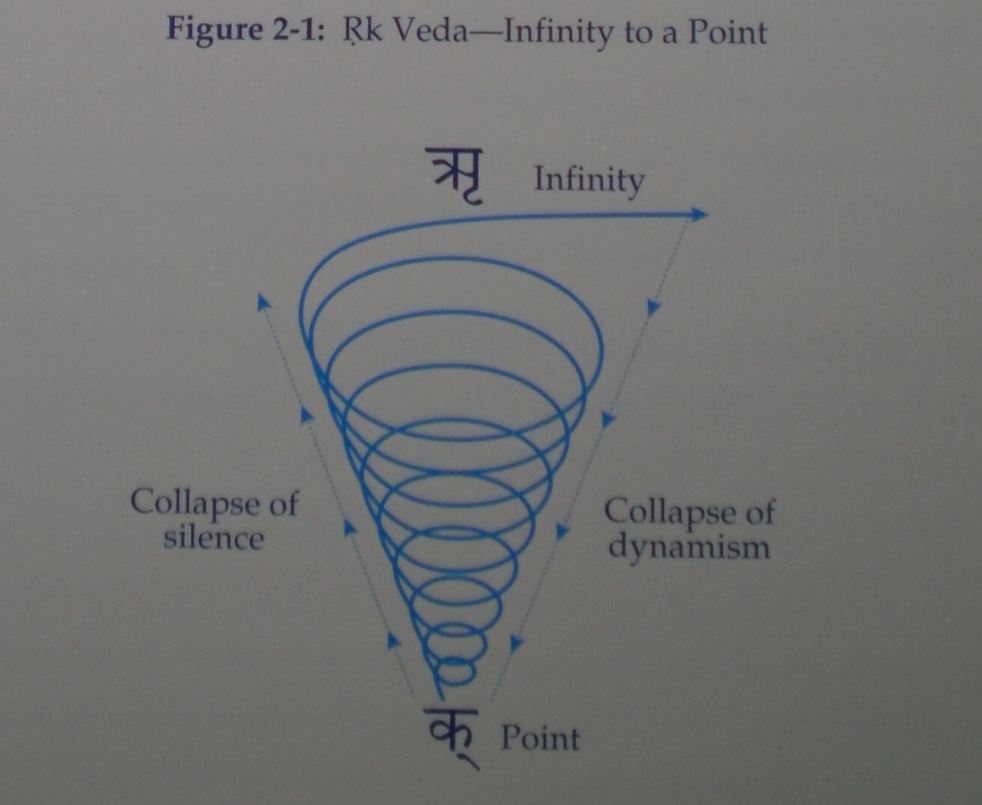
. cristal de la conscience : :20200503
We can say that the infinite set of points of view projected by samhita consciousness forms a crystal in the sense that all these points of view are linked together by the process of projection or discrimination, just as the links between atoms form a crystal..
The characteristic of a crystal is that its . entropie is very weak because of the bonds between the atoms.
cf entropy_and_information_in.
If everything is connected, entropy is zero.
The characteristic of the quantum state is that its entropy is zero..
A quantum system is described by a single wave function (cf . Premier postulat conscience glass) .
It is decoherence that creates the separation and means that the system can no longer be considered in terms of a single wave function, and must therefore be considered as several separate quantum systems..
This is how we move from a description by the quantum_mechanics_in to a description by the mechanics_statistics_in.
For example, all the electrons in a superconductor form a single wave function, so entropy is zero and there is no longer any resistance to the flow of electric current..
On the other hand, if the superconducting state is destroyed by the rise in temperature and we return to classical conductivity, the electrons are individualized and collide with the metal ions, resulting in high entropy..
Consciousness's projection of a point of view creates distancing.
This process of distancing creates a fundamental distance that cannot be measured, since it will become the yardstick for all measurement..
This fundamental, immeasurable distance defines the crystal mesh of consciousness..
The projection of consciousness is also a discrete mechanism, since there is no point of view that separates a subject from its projection..
This is why, at the most fundamental level, quantification is the key to success..
2.5.5.Fluctuating quantum vacuum
The boundless, infinite-frequency bubbling of points of view in consciousness can-be compared with the fluctuations
Planck-scale unified field quantum, also known as "space foam-time".
The Planck scale is the smallest scale conceivable by the dynamics of the forces of nature..
This is the natural scale of gravitational quantum phenomena, i.e. the scale of the dynamism of the unified field of physics..
We will make the connection with the fundamental distance of the projection of consciousness.
2.5.6.Infinite confinement of quarks
In physics, a similar mechanism has been devised to explain the strong nuclear force, i.e. the force that holds atomic nuclei together..
This is the theory of quarks and quantum chromodynamics..
In this theory, the particles that make up the atomic nucleus - protons and neutrons - are composed of quarks, even smaller particles that are bound together by a force carried by other particles called gluons..
In elementary particle physics, forces are always conveyed by particular particles grouped under the generic term "bosons", force particles..
The force or interaction between particles takes place through the permanent exchange of bosons..
The particles that exchange bosons are called "fermions" and are particles of matter..
Bosons and fermions are two categories of particles..
This is a fundamental duality of elementary particle physics: a particle is either a boson or a fermion.
This duality is expressed as follows: fermions are the building blocks of matter and bosons are the glue that binds them together.
This is how all the materiality we observe is constructed..
The distinctive nature of bosons and fermions goes deeper than this simple property, but this cannot be detailed here..
Gluons are the glue between quarks, hence their name..
The special case of gluons is the fact that they themselves are subjected to the force and therefore exchange-even new gluons, which by their very nature exchange-even more gluons and this, ... ad infinitum.
This is what is known as the infinite confinement of quarks and explains why this force is so strong..
If we try to separate two quarks that make up a proton, so much energy is required to fight against the many gluons that hold the quarks together that in the end there is enough energy to create two new quarks. (in line with Einstien's mass-energy equivalence: E = m c²) .
For this reason, quarks cannot be isolated; they always exist inside protons and neutrons..
All this to illustrate that this kind of recursive operation does exist in nature..
This mechanism was taken up in preon theory in an attempt to define a fundamental particle that would generate all other particles..
Two preons interact with each other via a new pair of preons, which can be represented by the following image :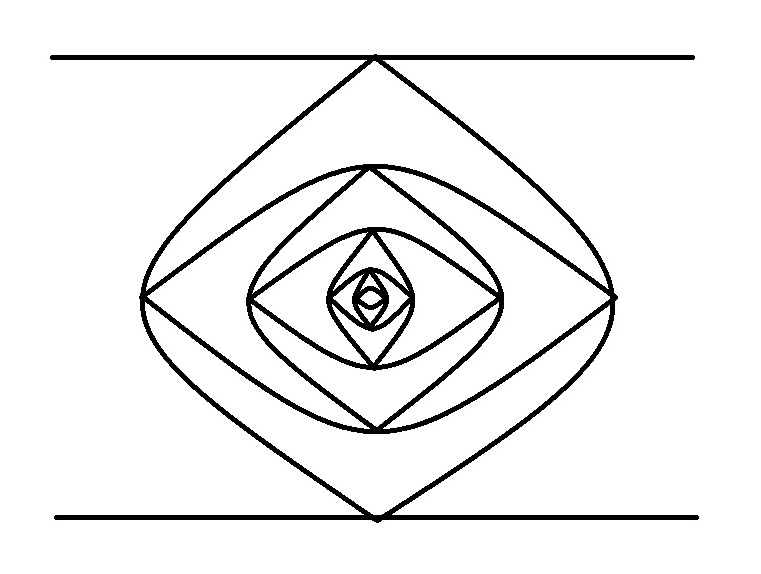
Back to our big bang.
It's a big bang of pure consciousness, with nothing yet possessing the properties of materiality..
Can-From this model, can we imagine a process for creating matter?2.5.7.The error of the intellect
Let's imagine, in this infinite bubbling, a point of view of consciousness projected far away that considers itself to be-even the source of points of view.
This is one possible point of view, even if it could be considered a
error, since it is not in fact the source of the points of view, the Samhita, but a projected point of view which possess
also like the other viewpoints, its way back to the Samhita.
The longer it takes, the more it corresponds
high projection, i.e. a high level of viewpoint generation.
This is called the error of the intellect..
Note that the Samhita can also be called the source of points of view, or simply the Source.
for what else is there, from what has been developed so far, other than points of view of consciousness?
What happens-t-then.
In this point of view, which considers him to be the source, it becomes impossible to return to the source.
to take the point of view that consists in going back to the Samhita.
This is impossible because it's
antinomic.
If we believe we are the source, we cannot logically believe that there is a way back to the Source..
What do we notice here? We're dealing with a choice.
At some point the conscience decides to make this choice
and thereby cut itself off from alternatives by prohibiting a return to the original position, to the point of view where the
consideration of other alternatives or possibilities is possible.
This is a new point of view, but
very special.
The ability to make choices is a fundamental characteristic of consciousness..
The same applies to the ability to give up a choice, i.e. to choose another alternative..
We can see here that something of the order of a rupture is taking place.
The projected point of view that considers it
is him-even the Source, creates a break in the continuum of consciousness we have observed until now.
This break is only created for this particular point of view, which we can now call a "entity"..
Indeed, from the point of view of the original consciousness, i.e. the Source, this is only one possible point of view,
that of separation.
But this separation is illusory; it has no absolute reality..
It only has a reality relative to the entity that has assumed this illusion..
By definition, for this entity
it is the only possible reality, since it is the very choice of separation that has created the entity..
We can call this entity a "separate entity". (of the original consciousness, of the Source) .
The rupture therefore exists only in the separate viewpoint, but paradoxically the separate viewpoint does not consider it as a rupture.
not so.
On the other hand, he assumes the consequences.
This is fundamentally related to Fifth_postulate_in of quantum mechanics and, more generally
the quantum measurement process described by postulates 3, 4 and 5.
The point we've touched on here has something to do with the concept of symmetry breaking in physics,
or the relationship between global and local symmetry.
These concepts are used in gauge field theory..
This concept considers a situation that is symmetrical on one side and a situation where the symmetry is broken, resulting in the appearance of a force..
In fact, the two situations are equivalent and correspond to two points of view on the same reality..
A simple illustration of this concept.
Consider a simple geometric line with two points A and B.
on this line and separated by a certain distance.
Let's consider another point O as a reference point, i.e. it's from this point that we'll observe points A and B.
Position point O exactly in the middle of the segment A,B_en.
Now let's define the way we observe things, i.e. the observation process..
We assume that in this system it is only possible to observe the distances.
By "distance" we mean only the distance separating the points, not the direction in which they are to be placed.
move from O to A or B, for example.
So direction won't be something observable.
So we use the concept of "observable" from quantum mechanics.
In this case, the distances between O and points A and B are the same.: d(O,A) = d(O,B) .
This means that for an observer of the system we have constructed, points A and B are identical..
The symmetry of this situation (A is symmetrical to B about O) cover for the observer
in position O a difference under-but which is not observable.
This is the case of unbroken symmetry.
Suppose now that the observer's position changes to O', which will be closer to A than to B
at which point the distances from O' to A and B are no longer equal.
On a d(O',A)
< d(O',B) .
The system has remained the same, but the difference can be seen by changing the point of view..
(the fact that the observable does not allow us to observe the "direction" property is illustrated in this example.
the concept of the hidden variable invoked in attempts to interpret quantum mechanics)
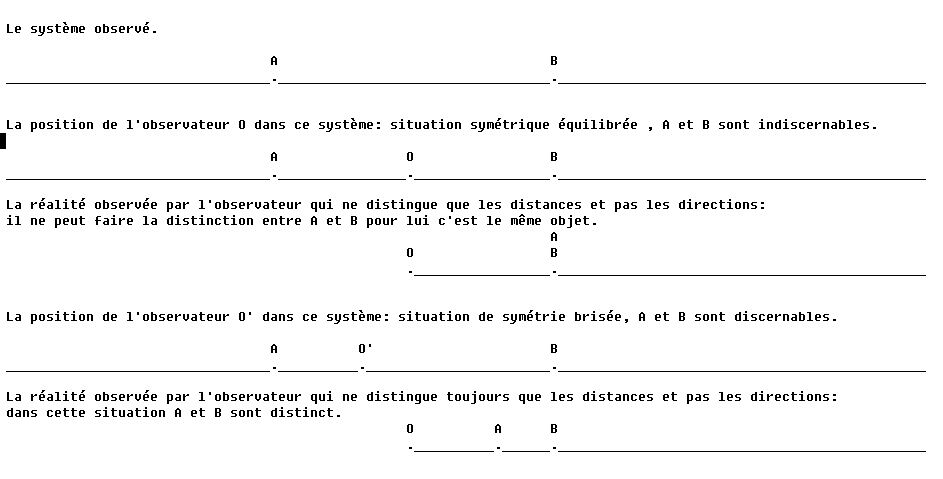
A simple translation reveals a different observable reality.
This simple example is analogous
to what happens in quantum mechanics, where the notion of observable was developed.
The importance of this concept is to separate fundamental reality from observable reality..
In quantum mechanics, it's the level of the system's wave function on the one hand, and the measurement on the other..
In simpler terms, we speak of reality on the one hand and phenomenology on the other..
The reality beneath-tend
all phenomenology, which makes it real, but only an appearance of reality..
Another way of saying this is to talk about manifest reality and unmanifest reality..
The psychoanalyst 2.5.7.1.1.Jung
introduced the notion of Unus Mundus to refer to the non-shown.
This non-to an influence on manifested reality via the mechanisms
of synchronicity.
This influence is not causal but final (because it brings meaning, purpose) .
Jung worked with the physicist Wolfgang Pauli because quantum mechanics provides a model of synchronicity through the concept of the non-transparent wave function.-and its local measurement highlighted in quantum entanglement phenomena, studied in particular by French physicists Alain . Aspect and Bernard_d_Espagnat
In this short video, he expresses himself clearly on the nature of reality : Bernard_d_Espagnat_sur_la_nature_de_la_réalité
From veda to ayurveda The creation of matter
When the error of the intellect occurs, i.e. when the intellectual process of discrimination of consciousness by it-even down to the point of view
of the separation between the source of views "the samhita" and the point of view
that considers itself to be the source when it is not.
a projected point of view, then consciousness finds itself in a very special situation.
special.
Consciousness that assumes this point of view cannot, by definition, go back to its source..
In fact, she can't think of a way back, since she considers herself the source..
This particular choice has an immediate consequence: The corresponding subject
to this point of view is irremediably separated from the object.
The totality can no longer be perceived as a unity (of samhita) since the only way to make such a
is to return to the source.
It is when the subject considers itself separate from the object that matter appears..
The subject perceives a surrounding world (everything that isn't him) and its ability to handle this world
is limited in both means of perception and means of action, depending on the depth of the projection level.
which distances it from the Source which is the domain of all possibility.
What is perceived can no longer be seen entirely as the discriminating activity of consciousness..
This is how life appears.
Visit veda_en becomes theayurveda_en
We can then give a definition of what life fundamentally is:
"Life is the materialized expression of consciousness".
This vision of life provides an understanding of quantum theory and resolves all its paradoxes..
the . Premier postulat of quantum mechanics asserts that the totality of information in a physical system
is contained in the data of a wave function or state vector.
The space of this wave function is an abstract space "non-physical" but which nevertheless, as we have seen, exists..
Direct proof of its existence can be found in quantum correlation experiments.
or non quantum entanglement-locale: space is an illusion.
In the space of consciousness there is not yet matter and energy or space.-time.
It's a non-local.
How can we distinguish between two non-local, this is impossible because to distinguish them they would first have to be localized..
In addition, it has been mathematically demonstrated that the wave function space known as Hilbert space is unique.:
_Alain_Connes_l_espace_de_hilbert_est_unique_2021_12_04
.
So the conclusion is inescapable: the space of consciousness and that of quantum reality are identical..
In the physical world there are objects and subjects to observe these objects..
From the big bang of consciousness emerges the separation of the big bang and the unfolding of the universe through the development_in_layer_of_the_universe_in
which will create increasingly complex and increasingly conscious structures until the appearance of brains supporting reflexive consciousness.
as for man, and it's only natural to assume that, well beyond the simple reflexive consciousness of the waking state, the development
state of consciousness, because wakefulness is merely a premise, an outcropping of unconsciousness into consciousness..
This can be verified simply by the fact that we are not conscious 24 hours a day and so we should humbly acknowledge
that we are only semi-conscious or partially conscious.
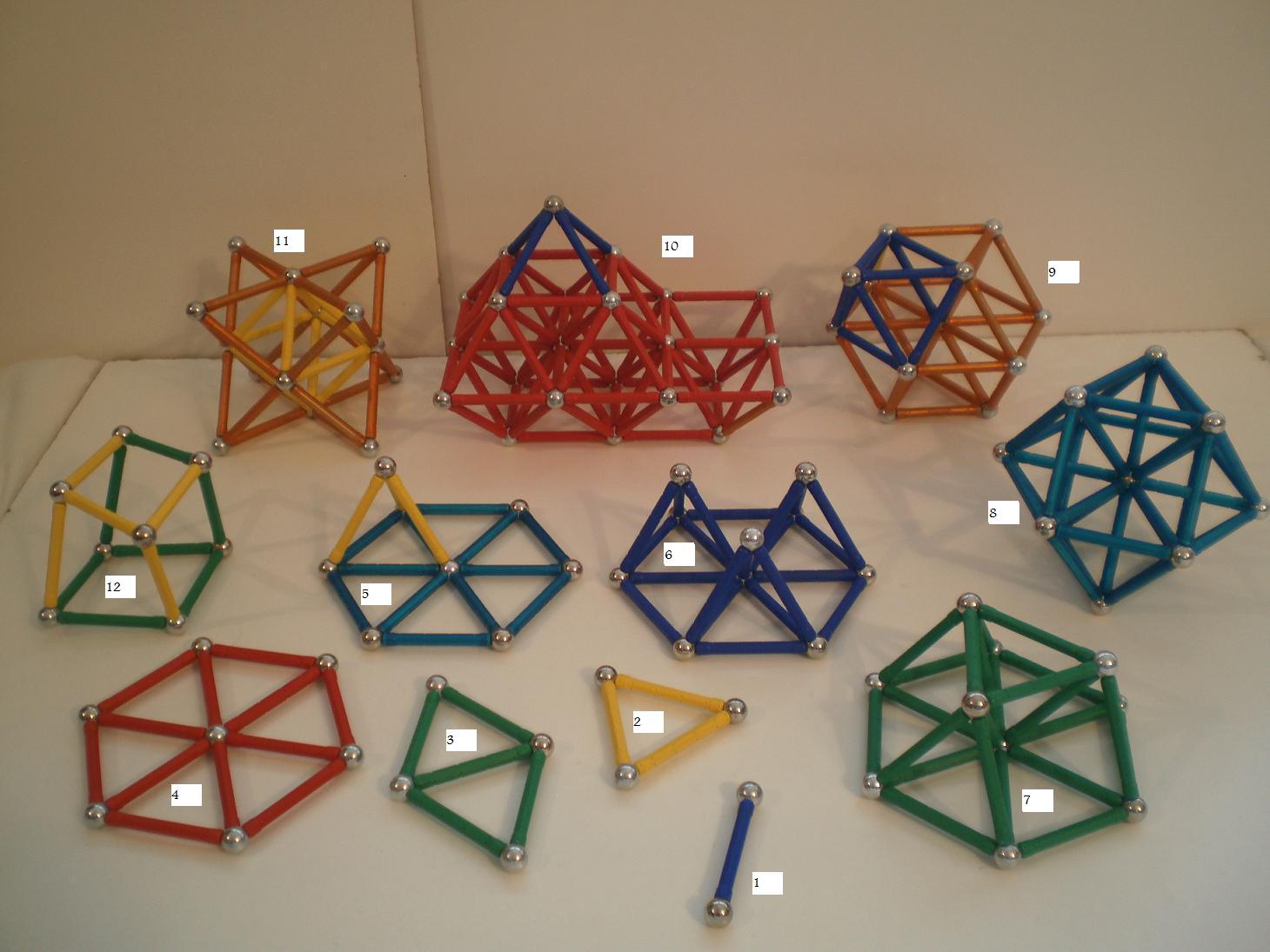
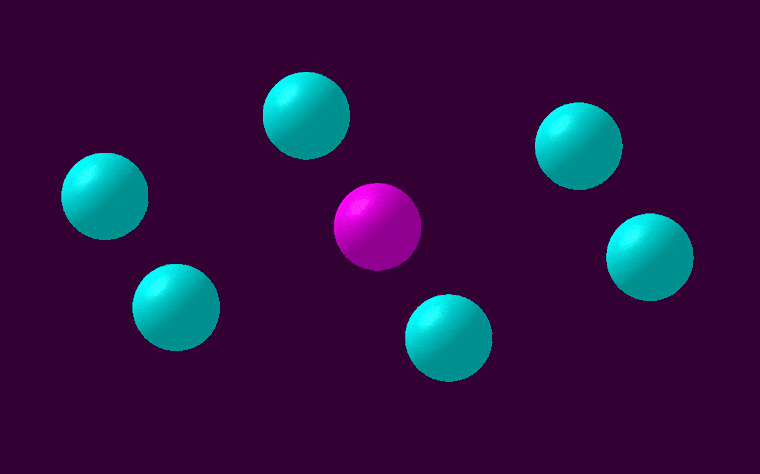
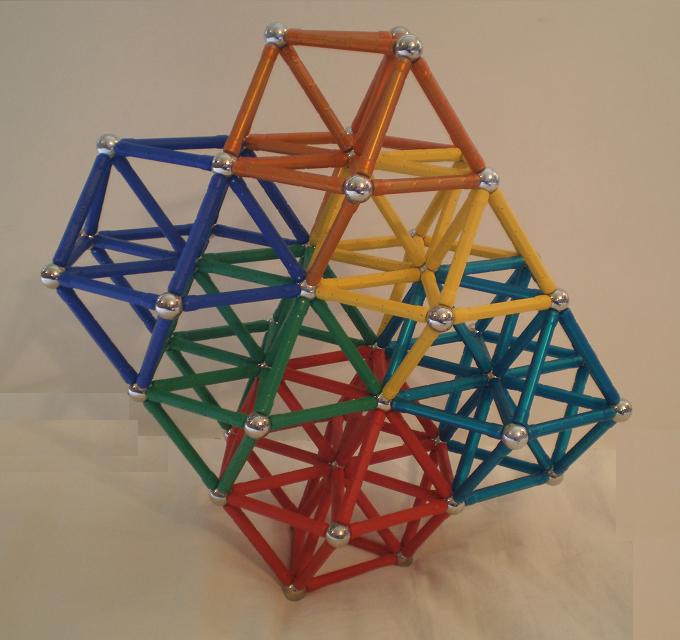
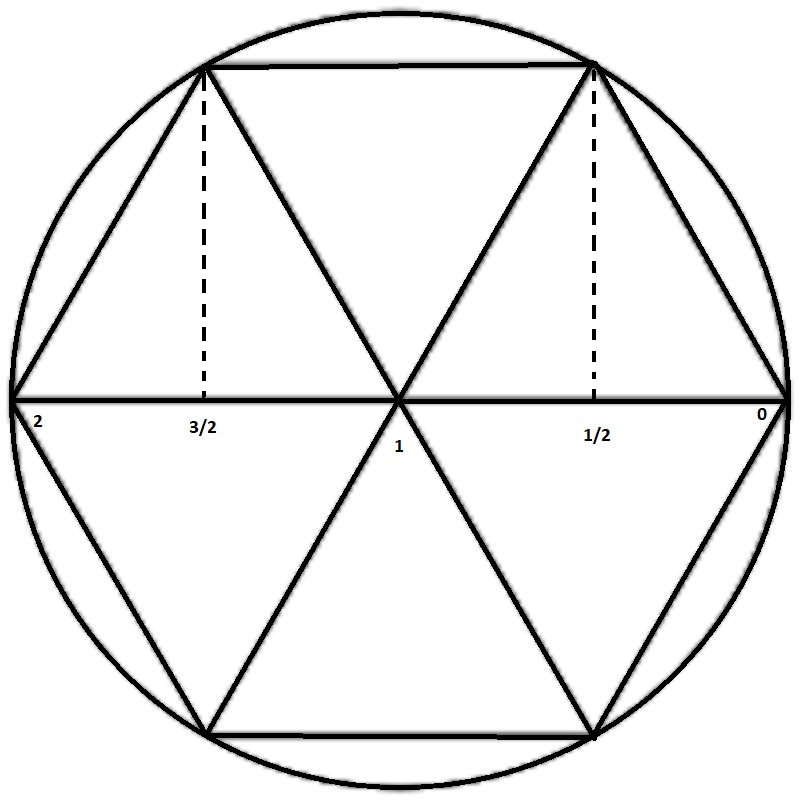

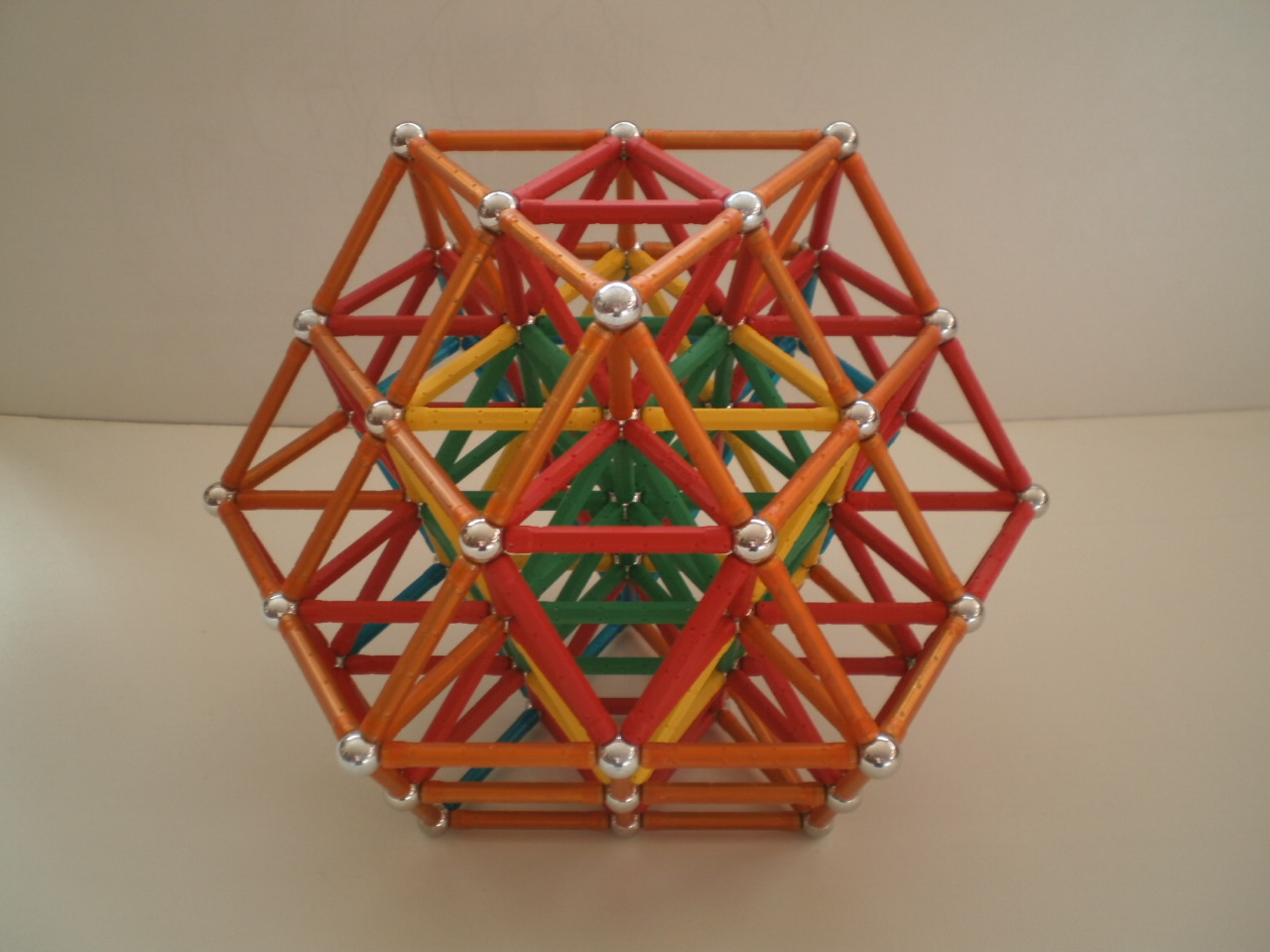
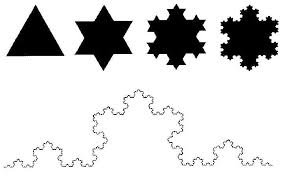

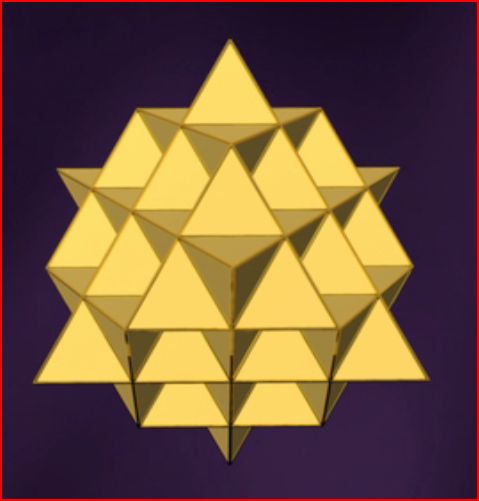
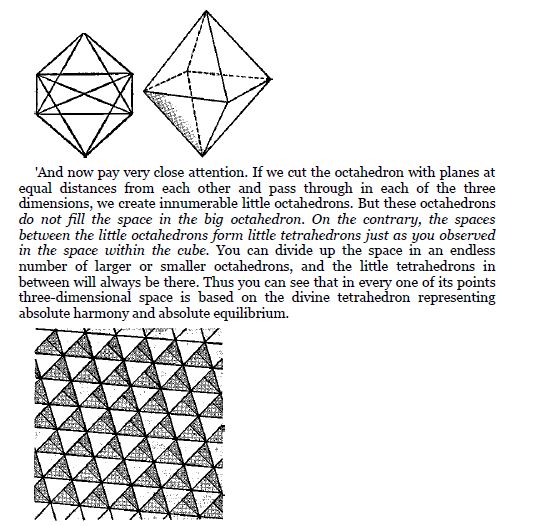
 The
The 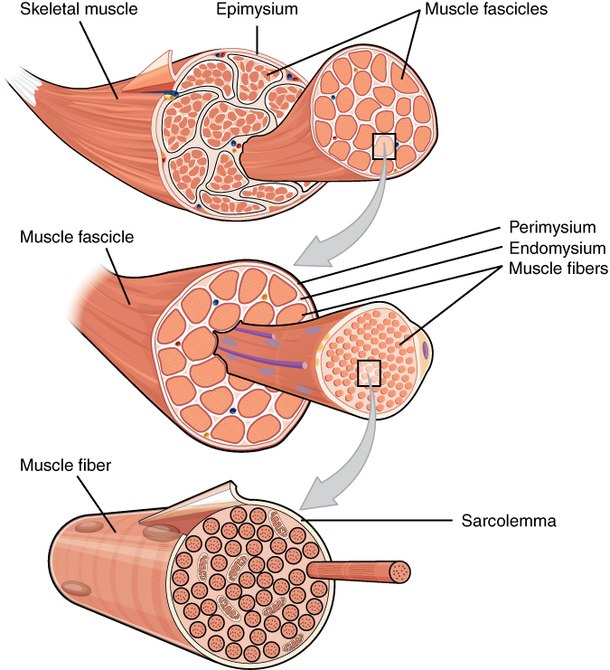 All the way to the body's overall structure.
All the way to the body's overall structure.